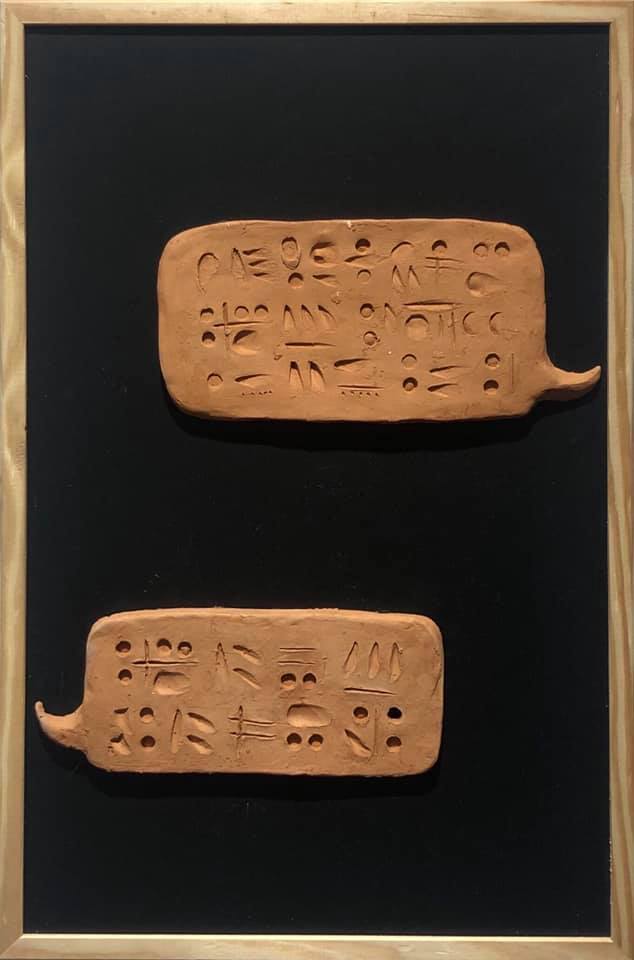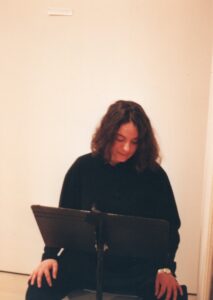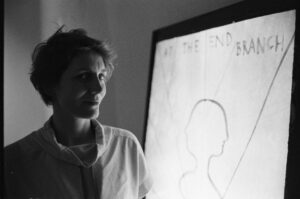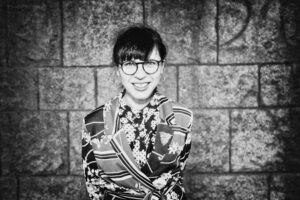Elsamina Musiq
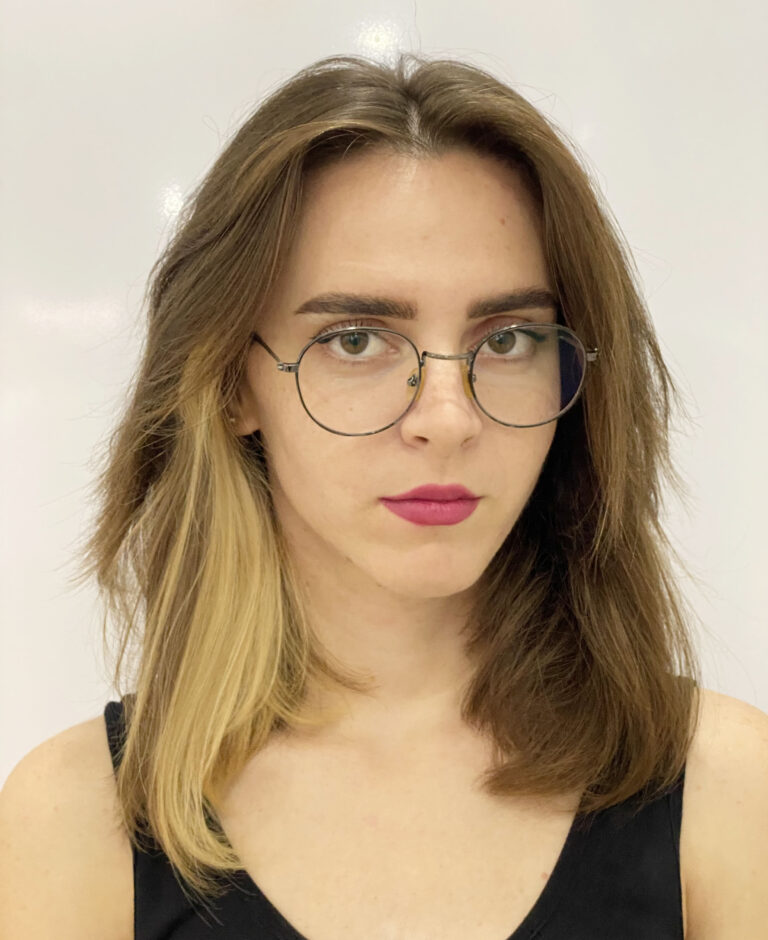
- body politics
- collaboration
- existential
- female body
- femininity
- feminism
- fiction
- figurative
- Gender Roles
- iconography
- identity politics
- individual memory
- installation
- literature
- multimedia
- myths
- national identity
- paper
- patriarchy
- Personal History
- photography
- remembrance
- self identification
- site-specific
- society
- tradition
- video art
– born in 1998 in Shkodër. Elsamina is a visual artist working with the mediums of photography, video-art, installation, performance, sculpture, painting and drawing. During the period from 2017 to 2020 she studied Painting-Graphics (BA) at the University “Luigj Gurakuqi” in Shkodër, while from 2020 to 2022 she graduated from Multimedia (MA) at the University of Arts in Tiranë.
I am of the opinion that it is easier to write about others than yourself and, therefore, I shall think in the third person while writing in the first person.
The first time I addressed the question to myself “Why do I work with art?” was when I was 16 years old; unlike my friends, working with art was not my primary choice, I was living somebody else’s dream – that of my twin sister. The pressure that a teenager can be put under is immense, specifically if it surrounds the future. Separating myself from my sister seemed to me like a tragedy; separation scared me to helplessness – the reality of this would suffocate me – and I rejected the reality of separation from a person with whom you are connected to without even really knowing them. This is a challenge because both of us are trying to create a separate identity, “Who is who”? Through art, we can impart our experiences effectively onto others.
Specifically inspiring was the fact that, other than the majority of the other people around us, I knew my ‘doppelgänger’, so why not try experimenting in this position. My last work depicting the issues of identity Face In The Mirror Is All I Need (2022)1, is a joint performance featuring the reality of similarity, using space to indicate that objects and external events that collide with one another often tolerate this encounter, whilst remaining independent of the other. This being a game for us and a dilemma for others, with the encounter being an active, constructive and aesthetic process.
Who are we? What makes sense? What is true? What can we know? What is the time? What is intelligence? What is common sense? Can everything be different as well? These are some of the questions of interest in my artistic practice.
I am of the opinion that looking for something, assumes a state of unawareness, including every existing thing – it becomes observable, admissible or intelligible. An artistic search strikes a balance between reasoning and innovation (innovation failing research would be pure intuition). Having an artistic experience means perceiving yourself beyond the frames and simultaneously entering within the frame – whereby this ‘framing’ may go beyond our perception. Knowledge and experience stand side by side as forms of recognition and I consider them equivalent to one another.
My medium is not a key focus of my practice; it is nothing more than a means to obtain the embodiment of the idea, to the effect of being as vivid as possible. This is one of the reasons why I decided to study Multimedia, i.e., far from restricting myself to a certain medium, instead embracing any medium and very often combining two or more mediums in a certain work. However, the mediums which are mostly encountered in my practice are: photography, video and installation – very often intertwined with more traditional mediums, such as painting, drawing and sculpture.
The creation process is very simple, often starting up with a primary idea and at other times expanding previous ideas. While not restricting myself in terms of selecting a medium, I see my work taking form in the suitable medium, which translates the idea/vision to the viewers more vividly. To me, works emerge out of casual ideas, which resonate through reality or out of a curious searching surrounding a certain topic.
It may well be that, in the course of a specific search, my artistic experience is alienated at different times, while experiencing changes in terms of significance. At what time and at which stage does the search become artistic? To me, the artistic experience is a form of reflection.
Poetics in the work Palimpsest III (2020-2022)2345 is an approach surpassing the visible, not simply as an artistic installation, but connected to life itself. The reference for Palimpsest comes from the book with the same title by Martin Camaj, – where he himself becomes the calculator of facts and events. Palimpsest in my case unveils an event organised by my grandmother, as a nurse, teaching kids under her care how to make paper boats to distract from the process of vaccination. The paper, being a delicate and very basic and minimalist format, sensitive to the touch … yet having such an effect on others. Oblivion in parallel to pain. In one paragraph of his book, Camaj writes: “There are circumstances in the life of a man that he would rather forget”. Unpleasant memories emerge unexpectedly, where you least expect it – for instance in our relations with others.
I see home as a very inspiring, motivating environment: the best environment for creativity and innovation. Creativity is subjective, essentially personal and sometimes difficult to be obtained on a sustainable basis. I like visualising inspiration as something comical, at the outset being without any sense and at the end meaningful. For instance, drawing the mysteries of the Bermuda triangle I place my main idea at the angles, while on the sides I place the expansion of this primary idea, in the centre is the reality, developing in an ‘inexplicable’ way, leaving behind no trace of the initial idea.
The information I obtain from the outside is processed by me at home, – a table, a chair, space and tranquillity are enough to spin the thread further. I keep my mind stimulated artistically, by taking a walk, going to the museum, a gallery, reading, listening to the radio – receiving information even from the journeys I undertake. My life experiences, interaction, passions, interests, reflections are all manifested in my works, changing with the passage of time. My work develops around my female gender and how I feel being within these boundaries; my personal reaction, re-evaluation and revocation of memories is what inspires me. I see and assign value to the most elementary and ordinary objects.
One of my projects is based on the novel of Ismail Kadare, The Ghost Rider (2019-2022)6789, with the main topics being: coming of Doruntina, resurrection of Konstandin and the pledge of Albanians – a project initiated in 2019, developed during the pandemic as in a phase of reflection and change. Trilogy: Doruntina / Konstandin / Stres, is a mystery unravelled by Kadare, but not by me.
The resurrection of Konstandin indicates that the strength of humans can be different from the one we actually perceive. The hope of resurrection, the belief of the resurrection of man, its energy and soul, at a time when the risk of extinction of the individual in the community was evident (published at the end of 70s in communist Albania). As long as these postulations contain some form of truth, the essence remains unrevealed: Doruntina was brought home by the boisterous wind of its changes, tremor and morale of the time, humanist search, rebellion of strong minds to provide humans with a sublime meaning.
In an isolated Albania, failing any friends or alliances, with no open doors, this depiction could bring about more alienation and could result in more bile. The story displays the onset, with some looking for closure. “Doruntina was brought home by the pledge, the Albanian pledge, a love adventurer, “someone” of the moment, etc…” – No, to this period of time, Doruntina was brought home by me – where a Doruntina can make it, while being in no need of a Konstantine in her life.
I think that the most important aspect of a well conceived work is that it has to be effective beyond the context it was initially created in.
A work of art is not simply the individual experience of the artist, but an entity added to the world. It is a moral, social and practical identity, a living being recognised and growing together with it: it is not a mere physical object, but a social entity also10. While the more meaningful it is to the others, the more relevant it becomes. Some works of art are doomed to cause tremor, while others serve indulgence – and why should we not make use of art to serve our mind.
I think that it is important to hold an open debate on what art is, on what constitutes its ethical value. Any person, who thinks that art is rubbish, should have someone explain to him where its real value is.
Statement written by the artist in conllaboration with Adela Demetja (2022).
1Image: Elsaida Musiq, Face In The Mirror Is All I Need, 2022, Performance, at Galleria FAB, Courtesy of the artist.2Image: Elsaida Musiq, PALIMPSEST 3, 2020-2022, Paper, plaster powder, Courtesy of the artist.
3Image: Elsamina Musiq, PALIMPSEST 3, 2020-2022, Paper, plaster powder, Photo Nadia Abazi, Courtesy of the artist.
4Image: Elsamina Musiq, PALIMPSEST 3, 2020-2022, Paper, plaster powder, Courtesy of the artist.
5Image: Elsamina Musiq, PALIMPSEST 3, 2020-2022, Paper, plaster powder, Photo Inda Sela, Courtesy of the artist.
6Image: Elsamina Musiq, The Ghost Rider, 2019-Ongoing, Digital photography series, Courtesy of the artist.
7Image: Elsamina Musiq, The Ghost Rider, 2019-Ongoing, Digital photography series, Courtesy of the artist.
8Image: Elsamina Musiq, The Ghost Rider, 2019-Ongoing, Digital photography series, Courtesy of the artist.
9Image: Elsamina Musiq, The Ghost Rider, 2019-Ongoing, Digital photography series, Courtesy of the artist.
10Image: Elsamina Musiq, SHAPES FROM THE EARTH, 2020, in cooperation with Xhulian Millaj, ceramic portrait with a diameter 15 cm, 2 ceramic tiles in fibre, 70 x 50 cm, Photo Xhulian Millaj, Courtesy of the artist.
– ka lindur më 1998 në Shkodër. Ajo është artiste vizuale që punon në mediumet e fotografisë, video-artit, instalacionit, performancës, skulpturës, pikturës dhe vizatimit. Në vitin 2017-2020 ka studiuar për Pikturë-Grafikë (BA) në Universitetin “Luigj Gurakuqi” në Shkodër, ndërsa në vitin 2020-2022 ka përfunduar studimet për Multimedia (MA) në Universitetin e Arteve në Tiranë.
Mendoj se është më e lehtë të shkruash për dikë tjetër sesa për punën tënde, prandaj do mendoj në vetën e tretë dhe do shkruaj në vetën e parë.
Hera e parë kur ia shtrova vetes pyetjen “Pse merrem me art?” ishte kur isha 16 vjeç. Ndryshe prej shokëve të mi, të merresha me art nuk ishte zgjidhja ime parësore; po jetoja ëndrrën e dikujt tjetër – motrës time binjake. Presioni që mund të ketë një adoleshente është i madh, sidomos nëse ka të bëje me të ardhmen. Të ndahesha nga motra më dukej si një tragjedi, më shkaktonte frikën sikur vetëm nuk do t’ia dilja, ku realiteti do më mbyste dhe refuzoja ta pranoja si realitet ndarjen me një person me të cilin isha e lidhur që pa lindur. Kjo përbën një sfidë, sepse ne sot po përpiqemi të krijojmë secila një identitet, “Kush është cila?”. Përmes artit ne mund të transmetojmë përvojat tona në mënyrë efektive tek të tjerët.
Ka qënë shumë frymëzuese fakti që ndryshe nga pjesa më e madhe e njerëzve që na rrethonin, unë e njihja “doppelganger-in” tim; pse jo të mos eksperimentonim me këtë rol. Puna më e fundit që trajton çështjet e identitetit është Face In The Mirror Is All I Need (2022)1, një performancë nga ne të dyja. Duke portretizuar realitetin e ngjashmërisë, hapësira tregon se përmbajtja e objekteve dhe e ngjarjes lejon përzierjen, njëra e pavarur nga tjetra; një lojë për ne dhe një dilemë për të tjerët, ku përballja është një proces aktiv, konstruktiv dhe estetik.
Kush jemi ne? Çfarë kuptimi kanë gjërat? Çfarë është e vërtetë? Çfarë mund të dimë? Çfarë është koha? Çfarë është inteligjenca? Çfarë është kuptimi? A mund të jetë gjithashtu gjithçka ndryshe? Këto janë disa nga pyetjet që më interesojnë në praktikën time artistike.
Mendoj se të kërkosh e pandeh gjendjen e të mosditurit, duke përfshirë çdo gjë që është, qoftë apo jo e vëzhgueshme, e pranueshme apo e kuptueshme. Një kërkimi artistik e vendos në baraspeshim mes arsyetimit dhe inovacionit (inovacioni pa kërkim do të ishte intuitë e pastër). Të kesh një përvojë artistike ndoshta do të thotë ta shikosh veten jashtë kornize dhe njëkohësisht të hysh në të, ku ky “kornizim” mund të kalojë përmes perceptimit tonë. Njohuria dhe përvoja qëndrojnë krah për krah si forma të njohjes dhe i konsideroj si ekuivalente.
Në krijimtarinë time mediumi nuk është pjesa ku tentoj të fokusohem aq shumë. Nuk është asgjë më shumë sesa një mjet që e përdor për të arritur trupëzimin e idesë sa më qartë që është e mundur. Kjo ishte edhe një nga arsyet pse vendosa të studioj Multimedia: moskufizimi i vetes ndaj një mediumi të caktuar, por përqafimi i çdo mediumi të mundshëm dhe shpesh herë kombinimi i dy ose më shumë mediumeve në një punë të caktuar. Megjithatë, mediumet më tepër të pranishme në krijimtarinë time janë: fotografia, video dhe instalacion. Shumë herë i ndërthur ato edhe me mediume më tradicionale si piktura, vizatimi dhe skulptura.
Procesi i krijimit është shumë i zakonshëm, shpesh duke filluar me një ide parësore dhe herë të tjera duke zgjeruar ide të mëparshme. Duke mos e kufizuar veten ndaj qasjes së mediumeve, e shikoj veprën duke u materializuar në atë medium që i përshtatet dhe e përkthen idenë/vizionin më qartë tek shikuesi. Veprat për mua lindin nga ide rastësore, por që rezonojnë me realitetin, ose nga një kërkim që lind si pasojë e kuriozitetit për një temë të caktuar.
Gjatë një kërkimi specifik, përvoja artistike mund të ndodhë në kohë të ndryshme; të tjetërsohet në kohëzgjatje dhe të ndryshojë në rëndësi. Në cilën kohë dhe në cilën fazë kërkimi behet artistik? Përvoja artistike për mua është si një formë reflektimi.
Poetika në veprën Palimpsestit III (2002-2022)2345 është një vështrim përtej të dukshmes; jo thjesht si instalacion artistik, por e lidhur me vetë jetën. Referenca për Palimpsestin vjen nga libri me të njëjtin titull të Martin Camajt, ku ai vetë bëhet llogaritës i fakteve dhe ngjarjeve. Në rastin tim, Palimpsest tregon një ngjarje të organizuar ku gjyshja ime, si infermiere, u mësonte fëmijëve të bënin varka prej letre që të mos ndjenin dhimbje gjatë procesit të vaksinimit; letra, një format delikat, shumë bazike, minimaliste, e ndjeshme gjatë prekjes… me efekt te të tjerët. Harresa paralelisht me dhimbjen. Në një paragraf të librit, Camaj shkruan: “Ka rrethana në jetën e njeriut që ky don me i harrue”. Kujtimet e pakëndshme lindin papritur aty ku nuk na e pret mendja, p.sh. në marrëdhëniet me të tjerët.
Shtëpinë e shikoj si një mjedis shumë frymëzues, motivues; ambienti më i mirë për kreativitet dhe inovacion. Kreativiteti është subjektiv, thellësisht personal dhe ndonjëherë i vështirë për t’u mbajtur mbi një bazë të qëndrueshme. Frymëzimin më pelqen ta vizualizoj si diçka komike, ku në fillim është i pakuptimtë dhe në fund bëhet kuptimplotë. Për shembull, duke vizatuar trekëndëshin imagjinar të Bermudës, tek kulmet vendos idenë parësore, tek brinjet vendos zgjerimin e kësaj ideje parësore, ndërsa në qendër realitetin që ndryshon në një mënyrë të “pashpjegueshme”, pa lënë gjurmë të idesë që ishte në fillim.
Atë informacion që marr nga jashtë e përpunoj nga shtëpia; një tavolinë, një karrige, hapësirë dhe qetësi më mjaftojnë për ta kapur fillin. E mbaj mendjen të stimuluar artistikisht duke bërë shëtitje, duke shkuar në muze, galeri, duke lexuar, duke dëgjuar radio; duke marrë informacione edhe nga udhëtimet që bëj. Përvojat e mia të jetës, ndërveprimet, pasionet, interesat, reflektimet, të gjitha manifestohen në veprat e mia duke ndryshuar me kalimin e kohës. Puna ime është rreth të qenit femër dhe se si ndihem duke qenë në ketë hapësirë; reagimi im personal, rivlerësimi dhe revokimi i kujtimeve është ajo që më frymëzon. Shoh dhe u jap vlerë objekteve më elementare dhe më të zakonshme.
Njëra nga projektet e mia bazohet në romanin e Ismail Kadare, Kush e solli Doruntinën? (2019-2022)6789, ku tematikat kryesore janë: ardhja e Doruntines, ringjallja e Konstandinit dhe besa e shqipetarëve. Një projekt i filluar në vitin 2019, ku zhvillimin thelbësor e pati gjatë periudhës së karantinës, si një fazë reflektimi dhe ndryshimi. Triologjia Doruntina, Konstandini, Stresi, është një mister i zgjidhur nga Kadare, por jo nga unë.
Ringjallja e Kostandinit tregon se fuqia e njeriut mund të jetë ndryshe nga sa ne e perceptojmë. Shpresa e një rilindjeje, besimi i ringjalljes së njeriut, të energjisë dhe shpirtit të tij, në një kohë kur rreziku i shuarjes së individit në bashkësi ishte evident (i botuar në fund të viteve ‘70 në Shqipërinë komuniste). Nëse në të gjitha këto pohime ka diçka prej së vërtetës, mbetet pa u thënë thelbi: Doruntinën e solli era e furishme e ndryshimeve të saj, tronditja dhe morali i kohës, kërkimi humanist, rebelimi i mendjeve të fuqishme për t’i dhënë njeriut kuptim sublim.
Në një Shqipëri të mbyllur, pa një mik, pa një aleancë, pa një portë të hapur, kjo ekspoze mund të sillte shumë pakënaqësi dhe të shkaktonte shumë mëri. Novela na shfaq hapjen, kur disa kërkonin mbylljen. “Doruntinën e solli fjala e dhënë, e solli besa shqiptare, e solli një aventurier dashurie, një “dikush” i rastit, etj etj,…” – Jo, në këtë epokë Doruntinën e solla unë me punën time, një Doruntinë mund t’ia dalë pa pasur nevojë për një Konstandin në jetën e saj.
Mendoj se aspekti më i rëndësishëm i një vepre të konceptuar mirë është se ajo duhet të jetë efektive jashtë kontekstit nëpër të cilin është krijuar fillimisht.
Një vepër arti nuk është vetëm përvoja individuale e artistit, por një entitet që i shtohet botës. Eshtë një identitet moral, social dhe praktik; një qenie që njihet dhe lidhet me të. Nuk është thjeshtë një objekt fizik, por edhe një entitet social.10 Dhe sa më shumë të ketë kuptim për të tjerët, aq më shumë është e rëndësishme. Disa vepra arti janë të destinuara për të tronditur, ndërsa disa të tjera për të kënaqur. Pse të mos e përdorim artin për t’i shërbyer mendjes?!
Mendoj se është e rëndësishme të mbahet një diskutim i hapur mbi atë që është art, atë që përbën vlerën e tij etike. Çdo person që mendon se arti është budallallëk duhet të ketë dikë që mund t’i shpjegojë se ku është vlera e tij e vërtetë.
Tekst i shkruar nga artistja në bashkëpunim me Adela Demetja-n (2022).
1Imazh: Elsaida Musiq, Fytyra në pasqyrë është gjithçka që kam nevojë, 2022, Performance tek Galeria FAB, Kortezi e artistes.2Imazh: Elsamina Musiq, PALIMPSEST 3, 2020-2022, Letër, pluhur gëlqere, Kortezi e artistes.
3Imazh: Elsamina Musiq, PALIMPSEST 3, 2020-2022, Letër, pluhur gëlqere, Foto Nadia Abazi, Kortezi e artistes.
4Imazh: Elsamina Musiq, PALIMPSEST 3, 2020-2022, Letër, pluhur gëlqere, Kortezi e artistes.
5Imazh: Elsamina Musiq, PALIMPSEST 3, 2020-2022, Letër, pluhur gëlqere, Foto Inda Sela, Kortezi e artistes.
6Imazh: Elsamina Musiq, Kush e solli Doruntinën?, 2019-2022, Seri fotografish digjitle, Kortezi e artistes.
7Imazh: Elsamina Musiq, Kush e solli Doruntinën?, 2019-2022, Seri fotografish digjitle, Kortezi e artistes.
8Imazh: Elsamina Musiq, Kush e solli Doruntinën?, 2019-2022, Seri fotografish digjitle, Kortezi e artistes.
9Imazh: Elsamina Musiq, Kush e solli Doruntinën?, 2019-2022, Seri fotografish digjitle, Kortezi e artistes.
10Imazh: Elsamina Musiq, FORMA NGA TOKA, 2020, në bashkëpunim me Xhulian Millaj, Qeramikë diametër 15 cm, 2 pllaka qeramike, 70 x 50 cm, foto Xhulian Millaj, Kortezi e artistes.
- body politics
- collaboration
- existential
- female body
- femininity
- feminism
- fiction
- figurative
- Gender Roles
- iconography
- identity politics
- individual memory
- installation
- literature
- multimedia
- myths
- national identity
- paper
- patriarchy
- Personal History
- photography
- remembrance
- self identification
- site-specific
- society
- tradition
- video art
